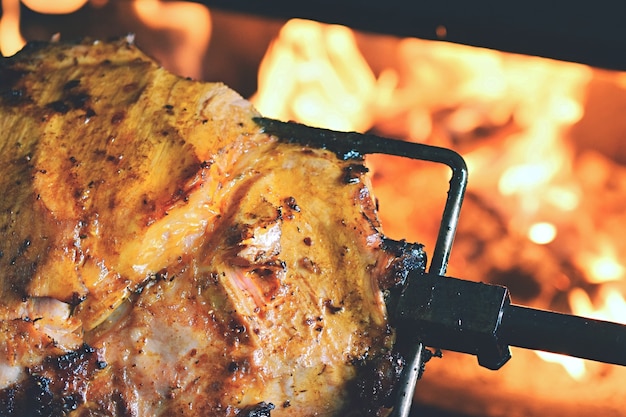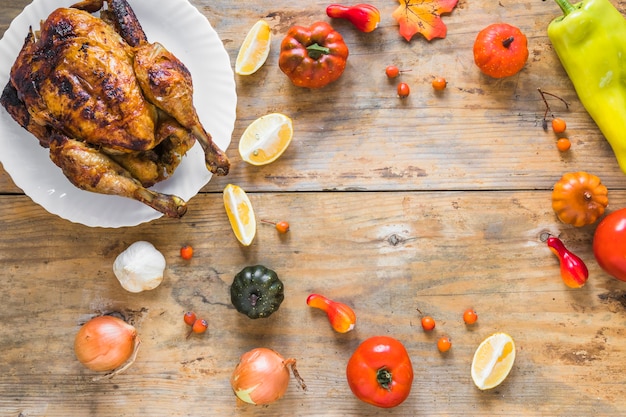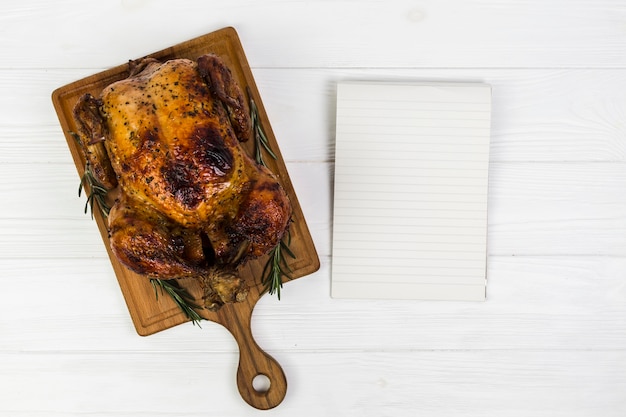There's nothing quite like the comforting aroma of a perfectly roasted chicken filling your kitchen. It's a meal that evokes memories of home, promises a delicious feast, and thankfully, is a whole lot less hassle than many other dishes. For years, rotisserie chicken has been my go-to for a quick, satisfying meal, and I've learned a few tricks along the way to ensure it's always juicy, flavorful, and utterly irresistible.
So, grab a comfy chair, get a cuppa, and let's dive into the world of rotisserie chicken. This guide will cover everything from choosing the right bird to mastering the art of seasoning, along with some handy tips and tricks to help you achieve rotisserie perfection. Ready? Let's get started!
(Part 1) Choosing the Right Chicken

The first step to a delicious rotisserie chicken is selecting the right bird. I've learned that there's no one-size-fits-all approach here - it depends on your needs and what you're aiming for.
What Size Chicken Should I Get?
I typically go for a whole chicken, usually around 2.5-3kg. That's enough to feed a family of four, and there are usually plenty of leftovers. A smaller chicken, around 1.5kg, is perfect for a couple or smaller families. When I'm cooking for just myself, I often opt for a whole chicken breast, which is perfect for a quick and easy meal.
Organic or Not?
This is a personal preference, but if you're looking for the most flavorful and ethically raised chicken, I'd recommend going organic. organic chicken is often free-range and raised on a more natural diet, which can make a significant difference in the taste. However, it's definitely more expensive. You'll find organic chicken in most supermarkets these days, and it's usually clearly labeled.
Fresh or Frozen?
Fresh chicken is always best, as it has a more intense flavour. But, if you're in a pinch, frozen chicken works just fine. Just be sure to thaw it completely before cooking. I always put my frozen chicken in the fridge overnight to thaw slowly, ensuring a more even thaw.
(Part 2) Getting Ready to Roast

Now that you've got your chicken, it's time to prepare it for roasting. Don't worry, this part is easier than you think. It’s all about prepping your chicken and making sure it's seasoned just right.
1. Pat it Dry
First things first, pat the chicken dry with some kitchen paper. This helps to get rid of excess moisture and ensure that the skin crisps up nicely during roasting. Nobody wants a soggy chicken skin!
2. Season It Up
This is where the real magic happens! I love to experiment with different seasoning blends, but there are a few classics that always work well. Here are some of my go-to combinations:
- Simple Salt and Pepper: This is the most basic, but sometimes the most effective. Just use generous amounts of salt and pepper, and you're good to go.
- Herbs and Spices: I love adding a mix of herbs and spices to my chicken. Think rosemary, thyme, garlic powder, paprika, and onion powder. The possibilities are endless! You can even create your own signature blend by experimenting with different combinations.
- Citrus Rub: If you're looking for a tangy twist, try a citrus rub. Simply combine lemon zest, orange zest, garlic powder, and salt. It's a delicious way to add a bright flavour to your chicken.
- Garlic Butter Rub: A simple mix of softened butter and minced garlic creates a flavorful and aromatic rub that's sure to impress. You can add a pinch of herbs like parsley or chives for extra flavor.
3. Get the Butter In!
My secret weapon for a juicy, flavorful chicken? Butter! I love to rub a generous amount of butter under the skin and all over the chicken. It helps to keep the meat moist and adds a beautiful richness to the flavour. Don't forget to put a little bit of butter in the cavity of the chicken too - it'll help with the roasting process.
(Part 3) Roasting the Chicken

Now comes the fun part - roasting! This is where you need to be patient and let the oven do its work. But trust me, the results are worth it. I've learned through trial and error that there are some key things to keep in mind when roasting your chicken.
1. Preheat Your Oven
Always preheat your oven to a high temperature, usually around 200°C (400°F). This helps to create a crispy skin and cook the chicken evenly. I usually preheat my oven for about 15 minutes before I put the chicken in.
2. Roast for the Right Time
roasting time varies depending on the size of the chicken. A general rule of thumb is to roast a whole chicken for about 1.5-2 hours, or until the internal temperature reaches 74°C (165°F). A meat thermometer is a must-have for anyone who roasts chicken. It helps to ensure that the chicken is cooked through and safe to eat. You can find these in most supermarkets.
3. Basting is Key
Basting the chicken during the roasting process is crucial for achieving that golden-brown, juicy chicken. I usually start basting after about 30 minutes of roasting. Simply use a spoon or basting brush to pour the drippings from the bottom of the pan over the chicken. This helps to keep the skin moist and the chicken juicy.
4. Rest the Chicken
After you've taken the chicken out of the oven, it’s important to let it rest for about 10-15 minutes before carving. This allows the juices to redistribute, which makes for a more tender and flavorful chicken.
(Part 4) Rotisserie Chicken: Beyond the Basics
Let's be real, a perfectly cooked rotisserie chicken is a masterpiece. But why stop there? We can take our chicken game to the next level! I'm talking about adding extra flavours and making our chicken even more delicious.
1. Stuffing the Cavity
One of my favourite tricks is to stuff the chicken cavity with aromatic ingredients. This adds a delicious depth of flavour to the chicken. My go-to stuffing is a simple mix of chopped onions, garlic, herbs, and a little bit of butter. I also love to use fruit like apples or oranges. The acidity of the fruit helps to balance the richness of the chicken.
Stuffing Variations:
- Citrus and Herb Stuffing: Combine lemon or orange slices with fresh herbs like rosemary, thyme, and sage for a refreshing and fragrant stuffing.
- Savory Bread Stuffing: Crumble some crusty bread and toss it with chopped vegetables, herbs, and a little bit of broth for a hearty stuffing.
- Spicy Stuffing: Add a kick to your chicken with a stuffing that includes jalapeno peppers, chili powder, and cumin.
2. Roasting Vegetables Alongside
Why not roast some vegetables alongside the chicken? It's a super easy way to add another dimension to your meal. I love to roast potatoes, carrots, and onions with my chicken. They soak up all the delicious flavours from the chicken and make for a truly satisfying meal.
Vegetable roasting tips:
- Cut Vegetables Evenly: Ensure even cooking by cutting vegetables into similar sizes.
- Toss with Olive Oil and Seasoning: Coat vegetables with olive oil and your favorite seasonings like salt, pepper, herbs, or spices.
- Don't Overcrowd the Pan: Ensure vegetables have space to roast evenly, spreading them out on the baking sheet.
3. Making a Delicious Sauce
The drippings from the chicken are pure gold! They can be used to make a delicious sauce to serve with your chicken. Simply strain the drippings, add some butter, flour, and a splash of stock, and simmer until the sauce thickens. You can even add some herbs and spices for extra flavour.
Sauce Variations:
- Pan Sauce: Add a tablespoon of butter to the roasting pan and scrape up the browned bits. Deglaze the pan with a little white wine or broth, then simmer until thickened for a rich and flavorful sauce.
- Creamy Sauce: Add a splash of cream to the pan sauce for a luxurious and creamy accompaniment to your chicken.
- Lemon-Herb Sauce: For a bright and refreshing sauce, whisk together lemon juice, herbs like parsley and dill, and a bit of olive oil.
(Part 5) Rotisserie chicken recipes: Inspiration for Every Taste
Let’s get creative! Here are some rotisserie chicken recipes that will blow your taste buds away.
1. Lemon and Herb Chicken
This is a classic for a reason. It's simple, flavorful, and always a hit. Simply rub the chicken with a mix of lemon zest, herbs, and garlic powder, then roast according to the instructions above. Serve with roasted vegetables and a squeeze of lemon juice.
2. Honey Garlic Chicken
For a sweet and savory flavour combination, try honey garlic chicken. Brush the chicken with a mix of honey, garlic, soy sauce, and ginger. Roast as usual. This is delicious served with rice and steamed vegetables.
3. Mediterranean Chicken
Bring the flavours of the Mediterranean to your kitchen with this recipe. Rub the chicken with a mix of olive oil, lemon juice, oregano, thyme, and garlic. Roast and serve with a side of couscous, olives, and feta cheese.
4. Spiced Chicken with Apricots
This is a bit more adventurous, but it's truly delicious. Rub the chicken with a mix of spices, like cumin, coriander, and turmeric, then stuff the cavity with apricots and onions. Roast as usual. This chicken is best served with a side of basmati rice and a dollop of yogurt.
(Part 6) Using Leftover Rotisserie Chicken
Let’s be honest, who doesn't love leftover rotisserie chicken? It’s so versatile! You can use it in countless ways to create delicious meals and snacks.
1. chicken salad
This is a classic way to use leftover chicken. Simply combine shredded chicken with mayonnaise, celery, onion, and your favourite herbs and spices. This is great for sandwiches, wraps, or as a salad topper.
2. Chicken Soup
Chicken soup is the ultimate comfort food, and it’s super easy to make with leftover rotisserie chicken. Simply simmer the chicken with vegetables, broth, and noodles. This is a delicious and comforting meal that’s perfect for a cold day.
3. chicken tacos
Shredded rotisserie chicken is a perfect filling for tacos. Simply add your favourite toppings like salsa, avocado, and sour cream. This is a quick and easy meal that’s perfect for a weeknight dinner.
4. Chicken Stir-Fry
Add some leftover chicken to your next stir-fry. It’s a great way to add protein and flavour to your meal. Simply add the chicken to your favourite stir-fry sauce and vegetables. This is a fast and delicious meal that’s perfect for a busy weeknight.
5. Chicken Pot Pie
Elevate your leftover chicken into a comforting pot pie. Combine shredded chicken with a creamy sauce, vegetables like peas and carrots, and top with a flaky pastry crust. It's a hearty and satisfying meal that's perfect for a cold evening.
6. Chicken Quesadillas
For a quick and easy lunch or snack, make chicken quesadillas. Simply layer shredded chicken, cheese, and your favorite toppings like onions, peppers, or salsa in a tortilla and grill until golden and melty.
7. Chicken Salad Sandwiches
A simple and classic use for leftover chicken is a chicken salad sandwich. Mix shredded chicken with mayonnaise, chopped celery, onion, and your favorite seasonings. Spread the mixture on your favorite bread and enjoy.
(Part 7) Rotisserie Chicken: Tips and Tricks
I’ve learned a few tricks over the years that have helped me create the perfect rotisserie chicken. Here are some of my top tips to help you achieve rotisserie perfection.
1. Don’t Overcrowd the Pan
Make sure that the chicken has enough space in the pan. If it’s crowded, it won’t cook evenly and the skin won’t get crispy. If you’re cooking a large chicken, you might want to use a larger roasting pan.
2. Use a Meat Thermometer
A meat thermometer is the best way to make sure your chicken is cooked through. I always use a meat thermometer, especially when cooking chicken. It takes all the guesswork out of the cooking process.
3. Don't Overcook It
It’s important not to overcook the chicken, as this can make it dry and tough. Make sure to check the internal temperature with a meat thermometer and take the chicken out of the oven when it reaches 74°C (165°F).
4. Let the Chicken Rest
Don’t rush into carving the chicken. It’s important to let it rest for about 10-15 minutes after it’s come out of the oven. This will allow the juices to redistribute, resulting in a more tender and flavorful chicken.
5. Elevate the Chicken:
Place a rack or trivet in the roasting pan to lift the chicken off the bottom. This allows for better air circulation and helps to create a crispier skin.
(Part 8) Rotisserie Chicken: Equipment You Need
For a smooth rotisserie chicken cooking experience, you’ll need a few key pieces of equipment. Don’t worry, it's not a long list, just a few essential items.
1. Roasting Pan
A good quality roasting pan is a must-have for any home cook. It should be large enough to accommodate your chicken and have high sides to prevent the drippings from spilling out.
2. Meat Thermometer
A meat thermometer is essential for ensuring that your chicken is cooked to the correct temperature. It’s also a handy tool for ensuring that your other meats are cooked safely.
3. Basting Brush
A basting brush is helpful for evenly applying butter and sauce to your chicken during roasting. It helps to keep the skin moist and the chicken juicy.
4. Kitchen Shears:
Kitchen shears are a helpful tool for cutting through the chicken's skin and bone. They make carving much easier.
(Part 9) FAQs
Now that we've covered all the bases of rotisserie chicken, let’s tackle those burning questions you might have.
1. How long does it take to cook a rotisserie chicken?
Roasting time varies depending on the size of the chicken. A general rule of thumb is to roast a whole chicken for about 1.5-2 hours, or until the internal temperature reaches 74°C (165°F).
2. What temperature should I cook my rotisserie chicken at?
Preheat your oven to a high temperature, usually around 200°C (400°F). This helps to create a crispy skin and cook the chicken evenly.
3. Can I cook a rotisserie chicken in a slow cooker?
You can cook a whole chicken in a slow cooker, but it won’t have the same crispy skin as a roasted chicken. The slow cooker will create a tender and flavorful chicken, but it won’t be as crispy.
4. What can I do with leftover rotisserie chicken?
Leftover rotisserie chicken is incredibly versatile! You can use it to make chicken salad, chicken soup, chicken tacos, chicken stir-fry, chicken pot pie, chicken quesadillas, chicken salad sandwiches, and any other dish that calls for cooked chicken.
5. Can I freeze rotisserie chicken?
Yes, you can freeze rotisserie chicken. To freeze, let the chicken cool completely, then wrap it tightly in plastic wrap and then in foil. The frozen chicken will last for up to 3 months in the freezer. When you’re ready to use it, thaw it in the refrigerator overnight.
And there you have it! With this comprehensive guide, you’ll be a rotisserie chicken master in no time. I’ve shared my secrets, my favourite tips, and some mouth-watering recipes. Now it’s your turn to get in the kitchen and create your own rotisserie chicken masterpiece! Happy cooking!
Everyone is watching

Perfect Rice Every Time: The Ultimate Guide to Cooking Rice
Cooking TipsAs a self-proclaimed foodie, I've always been a bit obsessed with rice. It's the foundation of countless cuisi...

Prime Rib Roast Cooking Time Chart: Per Pound Guide
Cooking TipsPrime rib roast. Just the name conjures images of lavish dinners, crackling fires, and hearty laughter. It’s ...

The Ultimate Guide to Cooking Asparagus: Tips, Techniques, and Recipes
Cooking TipsAsparagus. The mere mention of this spring delicacy conjures up images of vibrant green spears, crisp and burs...

Ultimate Guide to Cooking the Perfect Thanksgiving Turkey
Cooking TipsThanksgiving. Just the word conjures up images of overflowing tables laden with delicious food, the scent of r...

How Long to Bake Potatoes in the Oven (Perfect Every Time)
Cooking TipsBaked potatoes are a staple in my kitchen. They're incredibly versatile, delicious, and surprisingly easy to m...
